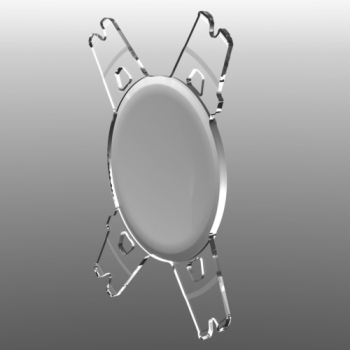May 3 2013
Bausch + Lomb, the global eye health company, announces the launch of its new INCISE® microincision intraocular lens (IOL). This enhanced acrylic IOL, in combination with the capabilities of the Stellaris® Vision Enhancement System, allows surgeons to perform microincision cataract surgery less than 2mm, delivering less invasive surgery for a more rapid visual recovery.[1]
 New INCISE(R) microincision intraocular lens from Bausch + Lomb. (PRNewsFoto/Bausch + Lomb)
New INCISE(R) microincision intraocular lens from Bausch + Lomb. (PRNewsFoto/Bausch + Lomb)
The new lens offers a number of features to deliver an enhanced experience for both the surgeon and patient and ultimately better outcomes. The INCISE IOL's aspheric advanced optics are designed to enhance visual quality.[3] The combination of an enhanced acrylic, improved Stellaris system capabilities and a new single use INCISE Viscoject Bioinjector enables 1.8mm in-the-bag and 1.4mm wound assist implantation enabling surgeons to benefit from a controlled sub-2mm MICS procedure.
INCISE has been designed to minimise posterior capsular opacification (PCO), a common long-term problem with IOLs that can cause patient vision to become clouded post-surgery. INCISE has a 360 degree barrier edge with a radius of curvature of 5 micro-m.[2] "INCISE has a much better edge profile than previous hydrophilic IOLs and has the best edge of any IOL we have ever imaged," said professor David Spalton , St. Thomas' Hospital, London, U.K.
"Sub-2mm cataract surgery with implantation of the INCISE IOL is a safe and effective micro-incision procedure," said university professor, Burkhard Dick , University of Bochum, Germany. "The unfolding of the lens was well controlled, allowing easy placement in the capsular bag. Overall, the performance of this new IOL during implantation and placement in the capsule was easy and predictable."
"The new INCISE lens is the latest innovation from Bausch + Lomb designed to meet the needs of both customers and patients. The combination of the enhanced material in the IOL and the new Viscoject Bio injector enables surgeons to deliver predictable injection performance and optical quality for sub-2mm delivery," said Cal Roberts , M.D., executive vice president and chief medical officer, Bausch + Lomb. "The addition of this next generation lens to our portfolio adds an exciting new option for ophthalmic surgeons performing micro-incision surgery."
The INCISE lens received CE Mark approval in the European Union and is not approved for sale in the U.S.
REFERENCES
[1] Kelman CD. Preface. In: Alio JL, Rodriguez Prats JL, Galal A, eds. "MICS Micro-incision Cataract Surgery," Miami: Highlights of Ophthalmology; 2004 /// 2. Agarwal A, et al. "Bimanual phaco. Mastering the phakonit/MICs technique," New Jersey: Slack Inc; 2004) // 3. Zheng L, Merriam JC, Zaider M. Astigmatism and visual recovery after large incision extracapsular cataract surgery and small incisions for phacoemulsification.
Trans Am Ophthalmol 1997; 95: 387-410».
[2] Altmann GE, Nichamin LD, Lane SS, Pepose JS. Optical performance of 3 intraocular lens designs in the presence of decentration. J Cataract Refract Surg. 2005; 31: 574-85.
[3] Spalton; Werner; Nishi: Edge profile is the most important preventing PCO /// Findl ;Cochrane analysis: PCO score lower with sharp edge design, no evidence of contributing role of the optic material.
®/™ are trademarks of Bausch & Lomb Incorporated or its affiliates.
© Bausch & Lomb Incorporated.